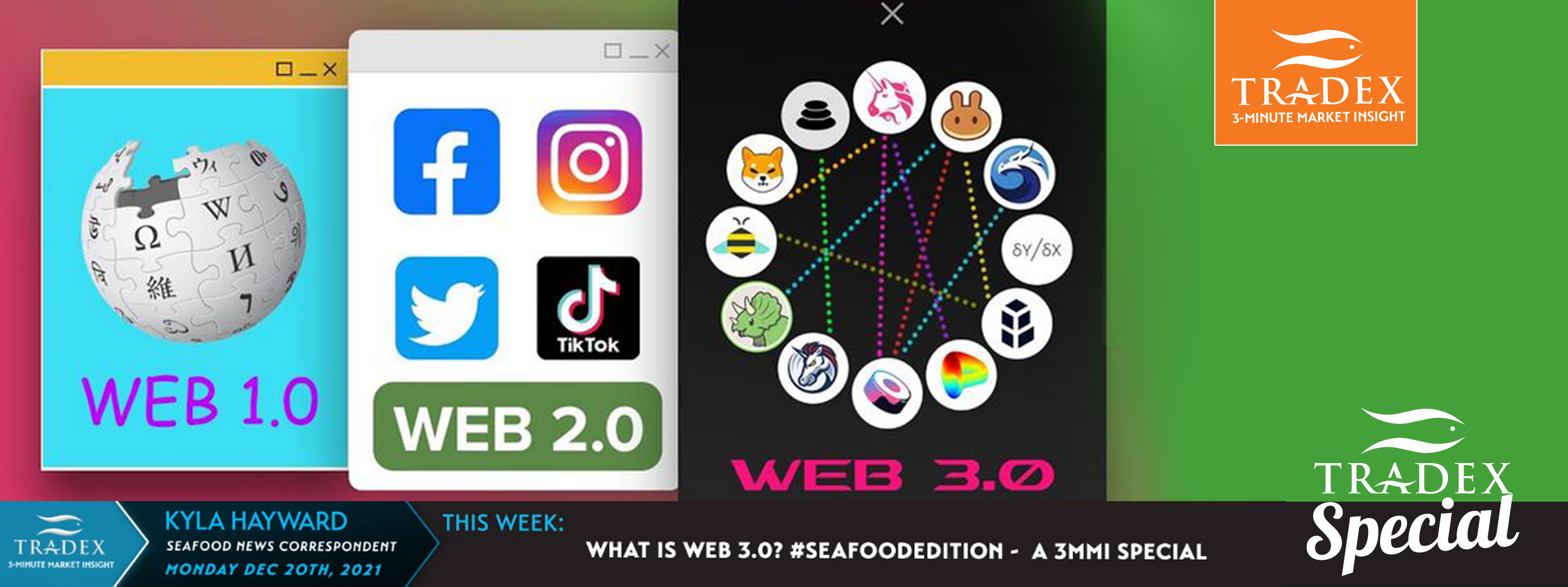
Loading
EP 569 | AIRED 12/20/2021
What is Web 3.0? #SeafoodEdition
December 20th, 2021 --- This week we brush the surface on what the heck Web 3.0 is, which includes terminology like Artificial Intelligence, Blockchain, Metaverse, NFT and Cryptocurrency - just to name a few.
--- Now you might be asking - Why are we reporting on this?
Well, Web 3.0 is the next phase of the web’s evolution and while we are currently at the tipping point of this next phase, as a business, if you don’t adapt, you will be left behind.
We would like to acknowledge that we are NOT providing financial or investment advice in this episode, and the purpose of this report is to help lightly understand some of the terminology in Web 3.0.
--- Let’s start off by showing the evolution of the web from Web 1.0 to Web 3.0.
Web 1.0 ran roughly from 1989 to 2005 and was known as the “Static Web”, as websites were basic read only html portals with little to no user interaction and where in most cases, webmasters were the only ones updating content for the web.

Web 2.0 ran roughly from 2005 to present day and is known as the “Social Web”, as websites became interactive which paved the way for social networks and user-generated content websites like YouTube to Facebook and Wikipedia.
This brings us to Web 3.0 which is the next stage of the web evolution, and the stage in which we are currently at the tipping point of.
Five main features can help us define Web 3.0 - they are Semantic Web, Artificial Intelligence, 3D Graphics, Connectivity, and Ubiquity.
Semantic Web
In a term coined by Tim Berners-Lee, the “inventor of the World Wide Web”, the “Semantic Web” improves web technologies in demand to create, share and connect content through search and analysis based on the capability to comprehend the meaning of words, rather than searching just a bunch of keywords or numbers.
Artificial Intelligence
Combining Artificial Intelligence with natural language processing, in Web 3.0, computers can distinguish information like humans in order to provide faster and more relevant results. They become more intelligent to fulfill the requirements of users. 3D Graphics
3D designs are currently being used widely in websites and services in Web 3.0 such as museum guides, computer games, e-commerce, geospatial contexts, etc. are all examples that use 3D graphics. The Spatial Web aims to blur the line between the physical and the digital by revolutionizing graphics technology, bringing into clear focus 3D virtual worlds.
Connectivity
For connectivity, with Web 3.0, information is more connected thanks to semantic metadata and as a result, the user experience evolves to another level of connectivity that leverages all the available information.
Ubiquity
Ubiquity means that content is accessible by multiple applications, every device is connected to the web, the services can be used everywhere.

Advertise Here: advertising@tradexfoods.com
Web 3.0 would make the internet more intelligent and process information with near-human-like intelligence through the power of Artificial Intelligent systems that could run smart programs to assist users.
Here’s an example of a future Business-2-Business experience in the food supply industry.
Let’s say MSC (the Marine Stewardship Council) creates a Web 3.0 App like Siri - let’s call it MSC in this case.
An executive for a grocery store could instruct the MSC Web 3.0 App to “order more sustainable seafood to cover store S1234 for the upcoming Lent Season”. With that one command, the MSC App could analyze all data sources to compute how much seafood that store needs for the upcoming lent season. The MSC App could then resolve to what it computes as the most reputable supplier of sustainable seafood (let’s say in this case it’s Tradex Foods with their 100 percent sustainability and reliability rating), all of which could be computed from trade data available on the blockchain. The MSC app would then connect with Tradex Foods, and the products would automatically be transported to the grocery store by an autonomous delivery truck or drone.
The reality of this B2B experience is just a concept, but it gives us something to think about in the present day on how business could be conducted in future stages of Web 3.0.
--- Artificial Intelligence will be a driving force in Web 3.0.
Elon Musk was recently quoted saying that “Artificial Intelligence will make jobs a bit pointless”, but also suggested to career youngsters that “If you’re working on something that involves people or engineering, it’s probably a good focus for your future,”

For the Foodservice industry, restaurant operators in the future would no longer need to worry about worker shortages as entire establishments could be run autonomously with Artificial Intelligent systems.
--- This next iteration of the web will leverage blockchain technology, open-source applications, and the decentralization of data and information.
You may have heard of Metaverse or NFT?
Imagine a Virtual World, where Seafood Producers sell Virtual Seafood, to Virtual Foodservice Operators, where Virtual Consumers consume Virtual Seafood, at a Virtual Venue.
Metaverse is a virtual-reality space in which users can interact with a computer-generated environment and other users.
An NFT (also known as Non-fungible token) is a digital certificate of authenticity written to the blockchain used to assign and verify ownership of a unique digital or physical asset.
Tech giants Facebook, Apple, Google, and Microsoft are already making investments in developing products that support augmented and virtual reality - something Wall Street sees as a 1 trillion dollar market.
Even household consumer brands from Nike to Martha Stewart have already made moves into this virtual world of digital assets.
As an alert to the Seafood Industry, even if you choose not to participate in this next phase, the small investments you make now to secure your brands intellectual property in the Web 3.0 space, will give you peace of mind, and could pay dividends later.
Remember in Web 1.0, not everyone purchased their domain or launched a website, and when they were finally ready, their domain was unavailable to be purchased.
We’ll end this episode here in order to keep it as light as possible.
Look out for upcoming episodes on Web 3.0 and the seafood business as we dive into NFT Blockchain Domains and other Blockchain intellectual property you can secure for your brand in preparation for Web 3.0.
--- And just a final note, this will be the last episode for 2021 as we will be taking a 1-week break for the holidays, and we will be back in the New Year on January 3rd, 2022 with a brand new episode.
From myself and everyone at Tradex Foods, have a safe and healthy holiday season and a Happy New Year.
--- If you are not already, be sure to subscribe to our 3-Minute Market Insight using the signup form below to keep tuned-in to all upcoming market insights.


